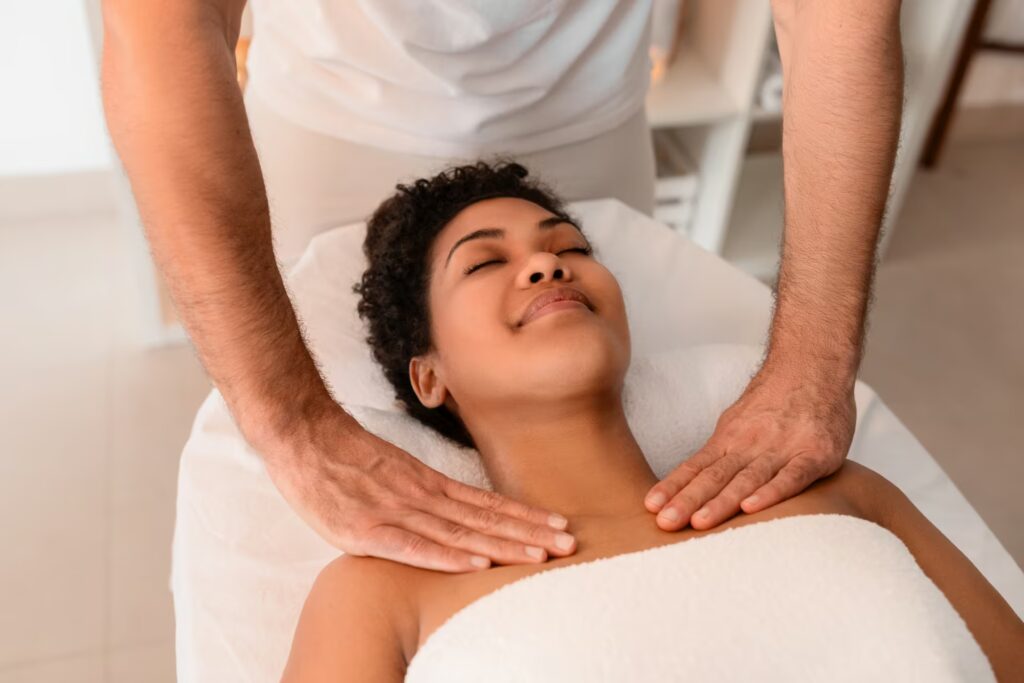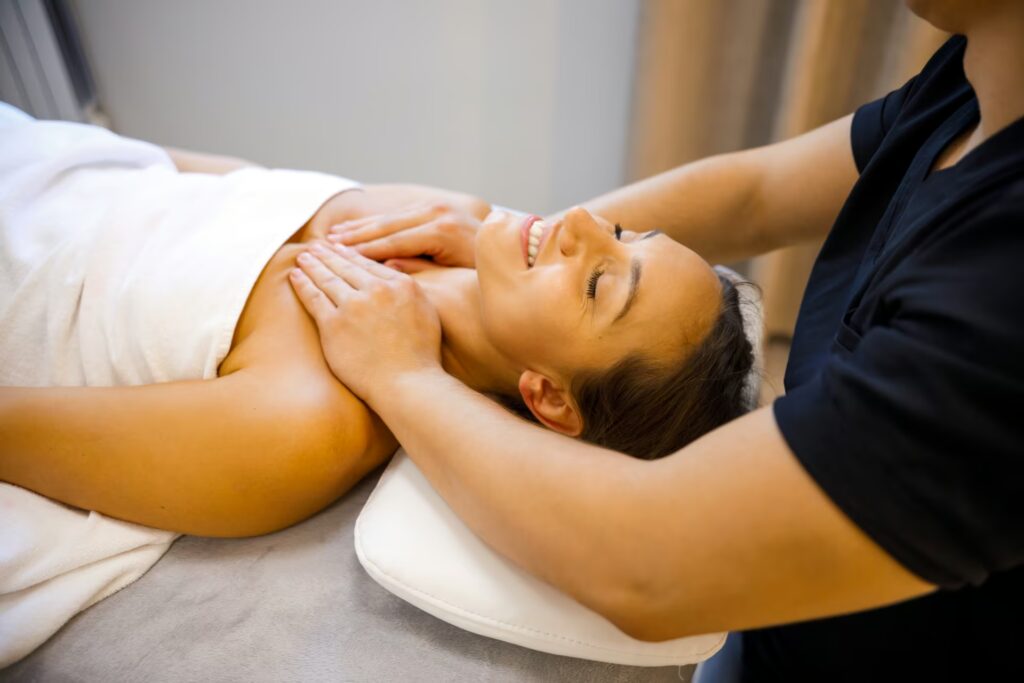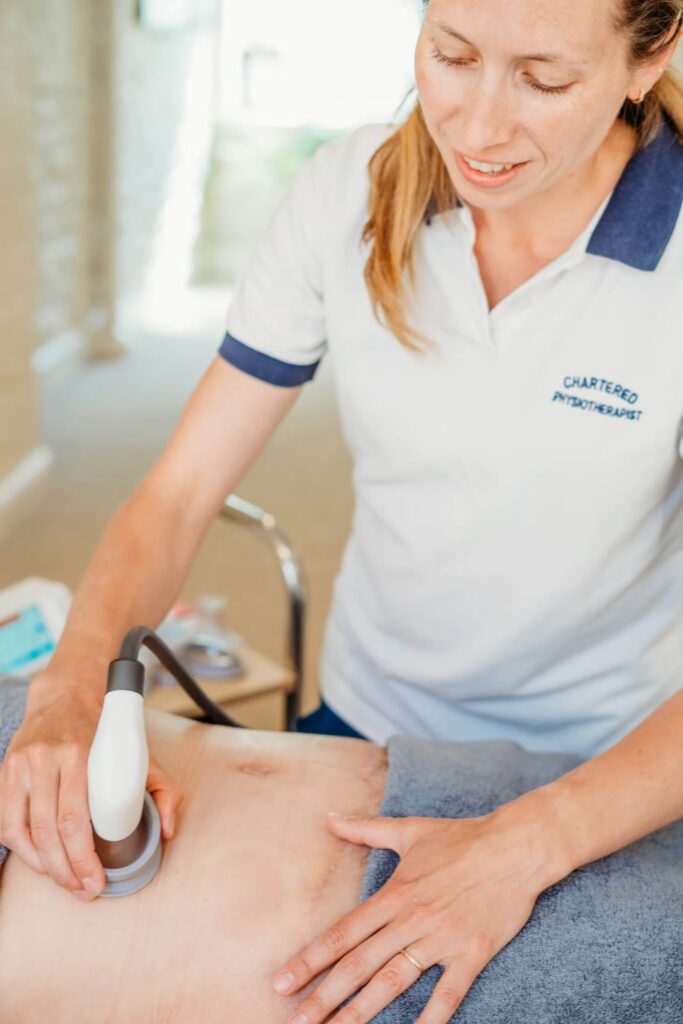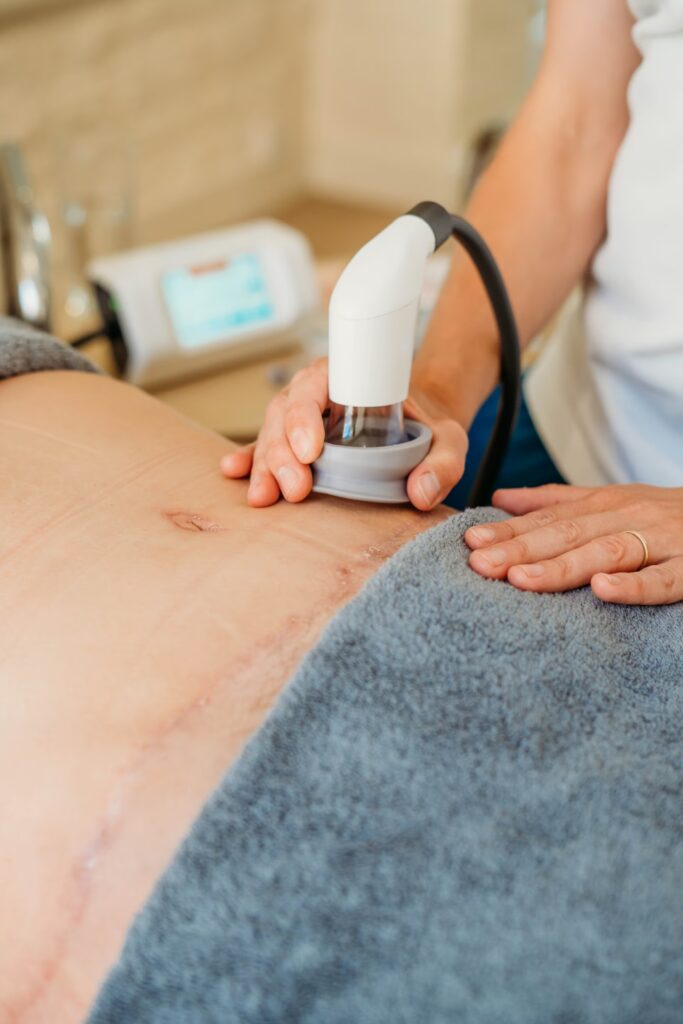
About Lymphatic Drainage
Manual Lymphatic Drainage is a gentle, rhythmic massage technique that stimulates the lymphatic system to remove excess fluid and waste from body tissues. It uses light, specific hand movements to encourage lymph flow and reduce swelling.
It is suitable for;
- Pre & postoperative cases (cosmetic surgery, cancer or where lymph nodes have been removed or the lymphatic system impaired in some way).
- Toxic build-up, oedema & fluid retention (puffy ankles, legs, eyes, bloating).
- Scar tissue (old & new)
- Stress, Anxiety, Tension.

Lymphatic Drainage Frequently Asked Questions
How does MLD differ from regular massage?
Unlike traditional massage that targets muscles, MLD uses very light pressure and rhythmic, circular movements focused on the skin surface. It follows specific pathways of the lymphatic system rather than addressing muscle tension.
What conditions or symptoms can MLD help treat?
MLD may help with lymphedema, post-surgical swelling, sports injuries, chronic fatigue, fluid retention, sinus congestion, fibromyalgia, rheumatoid arthritis, and as support during detoxification programs.
Is MLD specifically for lymphedema or can anyone benefit?
While MLD is effective for lymphedema management, it benefits many people, including those with swelling, poor circulation, inflammatory conditions, stress, skin problems, or those looking to support their immune system.
What happens during an MLD session?
The therapist begins by clearing lymph nodes near the collarbones and in the neck, then progresses to the affected areas using light, rhythmic movements in specific directions to encourage lymph flow toward drainage points. They will often treat the whole body for systemic effect unless the patient’s preference is to only address the affected area.
How long does a typical MLD session last?
MLD sessions typically last 60 minutes, depending on the areas being treated and the condition being addressed.
How many sessions would I need to see results?
Most clients notice improvements after 1-3 sessions. Chronic conditions may require 6-10 sessions followed by maintenance. We create personalized treatment plans based on your specific needs and response.
Is the treatment painful or uncomfortable?
No, MLD uses very light pressure and should never cause pain. Most clients find it deeply relaxing, sometimes describing the sensation as soothing waves moving across the skin.
Are there any side effects I should be aware of?
Some clients experience mild fatigue, increased urination, or temporary changes in symptoms as the body processes and eliminates excess fluid. These are normal responses that typically resolve within 24 hours.
What should I do before and after an MLD session?
Before: Stay well-hydrated and avoid heavy meals. After: Continue drinking plenty of water, rest if needed, and avoid intense exercise, alcohol, and very hot environments for 24 hours to support the detoxification process.
Unlike traditional massage that targets muscles, MLD uses very light pressure and rhythmic, circular movements focused on the skin surface. It follows specific pathways of the lymphatic system rather than addressing muscle tension.
Are there any contraindications for MLD?
MLD is not recommended for active infections, certain heart conditions, kidney failure, blood clots, or specific cancers. We conduct a thorough health assessment before treatment to ensure it’s appropriate for you.
Do I need a doctor's referral to receive MLD?
For general wellness, no referral is needed. For lymphedema or post-surgical cases, we recommend having medical clearance. For cancer-related lymphedema, a doctor’s referral is required.
How soon after surgery or cancer treatment can I receive MLD?
This varies based on your specific surgery and overall health. Generally, we require medical clearance, with most surgeons approving treatment after incisions have healed (typically 6 weeks). Cancer-related treatments require specific protocols.
Can MLD help with my specific condition?
We can assess your individual situation during a consultation. MLD helps many conditions involving inflammation, fluid retention, poor circulation, or immune system support.
How is MLD different from compression therapy?
MLD manually stimulates lymph flow, while compression therapy uses external pressure to prevent fluid buildup. They’re often complementary—MLD moves fluid out of tissues, while compression helps maintain the results.
Can I combine MLD with other treatments?
Yes, MLD works well with compression therapy, exercise programs, skin care, nutritional support, and certain other bodywork. We can help create an integrated treatment plan for your specific needs.

About LymphaTouch
LymphaTouch is a cutting-edge medical device that uses gentle negative pressure (vacuum) and mechanical vibration to supercharge your body’s natural healing process. By stimulating lymphatic drainage and breaking down scar tissue, it helps reduce swelling, improve circulation, and enhance overall well-being.
Unlike traditional methods, LymphaTouch works with your body to effectively remove excess fluid, accelerate recovery, and optimize movement—whether you’re healing from surgery, managing pain, or recovering from an injury.
LymphaTouch is ideal for:
- Pre- and post-operative swelling
- Scar treatment & softening
- Lymphedema management
- Acute injury recovery
- Releasing fascial restrictions
- Enhancing muscle recovery
- Pain relief & management
- Improving joint mobility

LymphaTouch Frequently Asked Questions
How is LymphaTouch different from Manual Lymphatic Drainage?
While both promote lymphatic flow, LymphaTouch uses negative pressure and vibration to provide deeper and more consistent stimulation, enhancing treatment efficiency.
What does a LymphaTouch treatment feel like?
Most people describe it as a gentle pulling or suction sensation, similar to a light massage, with a relaxing effect on the treated area.
Is LymphaTouch therapy painful?
No, LymphaTouch is designed to be comfortable. The suction level can be adjusted to suit your sensitivity and needs.
How long does a typical LymphaTouch session last?
Sessions typically last between 30 to 60 minutes, depending on the area being treated and your specific needs.
How many sessions will I need to see results?
Many people notice improvements after one session, but a series of treatments may be recommended for long-term benefits.
Are there any side effects I should be aware of?
Mild redness or temporary skin sensitivity may occur but usually resolves quickly.
What are the advantages of LymphaTouch over traditional methods?
LymphaTouch provides deeper and more targeted lymphatic stimulation, leading to faster results with less effort compared to manual techniques.
Is LymphaTouch safe for everyone?
It is generally safe, but certain conditions may require a consultation before treatment.
Unlike traditional massage that targets muscles, MLD uses very light pressure and rhythmic, circular movements focused on the skin surface. It follows specific pathways of the lymphatic system rather than addressing muscle tension.
Are there any contraindications for LymphaTouch therapy?
Yes, LymphaTouch is not recommended for individuals with acute infections, active cancer, deep vein thrombosis, or certain cardiovascular conditions.
What qualifications do your therapists have with LymphaTouch?
Our therapists are trained and certified in LymphaTouch therapy, ensuring safe and effective treatment.
Can LymphaTouch be combined with other treatments?
Yes! It complements physiotherapy, massage, and other rehabilitation therapies.
What should I do before and after a LymphaTouch session?
Stay hydrated, wear comfortable clothing, and avoid heavy meals before treatment. Afterward, drink water and rest as needed.
How soon after surgery can I receive LymphaTouch therapy?
This depends on your surgery and healing progress. Consult with your doctor or therapist for personalized advice.
Unlike traditional massage that targets muscles, MLD uses very light pressure and rhythmic, circular movements focused on the skin surface. It follows specific pathways of the lymphatic system rather than addressing muscle tension.